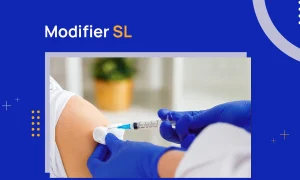Accuracy in medical coding is important to ensure you get timely reimbursements. However, many healthcare providers find this challenging and make many mistakes during billing. That’s especially true when it comes to physical therapy and rehabilitation codes.
That’s because there are a lot of similar codes that can be used in a situation, but only one of them is correct. Selecting the appropriate code from similar options requires attention to detail and a thorough understanding of each code’s specific application. CPT code 97760 is one such code that billers easily get confused with.
No worries, though! We have got your back with this guide. Here we will provide a simple breakdown of what CPT code 97760 is, when to use it, what modifiers to append, and how to bill it without messing up. So, let’s start.
97760 CPT Code Description
Okay, so what’s CPT code 97760 all about?
Well, the CPT code 97760 is used for orthotic management and training. This includes assessment and fitting when not otherwise reported. An important thing to note is that the 97760 is a time-based code and is applied when an orthotic device is fitted on the upper extremities, lower extremities, and/or trunk. It reports an initial encounter. The code is applied for every 15 minutes of service. This code is only for orthotics and not prosthetics, so you must remember these minute details before filing your claims.
Pretty complex, right? In plain English, it’s for that initial session where you:
- Figure out what the patient needs for their orthotic (like a brace or splint).
- Fit it on them and adjust it so it works just right.
- Show the patient how to use the orthotic device, like putting it on or off.
An important thing that most billers forget is that the CPT code 97760 is used only for outpatient places, like small clinics or rehab centers. Plus, it is used only for the first patient visit. Follow-ups get a different code (like 97763).
Appropriate Use Cases for CPT Code 97760
To make things more clear, let’s look at some everyday examples. Going through some scenarios will clarify when CPT code 97760 should be used.
Initial Fitting of Lower Extremity Orthotics
Consider a scenario in which a patient with foot drop due to peripheral neuropathy is prescribed an ankle-foot orthosis (AFO). He goes to a physical therapist to get the treatment. During his initial visit, the physical therapist assesses the patient’s gait, fits the AFO, makes necessary adjustments, and trains the patient on proper application and use, including skin inspection techniques. All of this was done in under 15 minutes.
In this case, the use of CPT code 97760 is perfectly justified because it was the patient’s first visit for an orthotics fitting, training, and management.
Please note that in this scenario, we haven’t included the gait evaluation, like climbing stairs or walking comfortably. That’s because gait is a different service billed separately under CPT code 97116.
Upper Extremity Orthotic Training
Let’s look at another potential use case of the 97760 code.
Let’s say a person with carpal tunnel syndrome receives a wrist orthosis. He visits an OPD, and the therapist spends 15 minutes fitting the device, adjusting it for optimal wrist positioning, and training the patient on proper use, including wearing schedules and exercise modifications.
The billing department can now file the insurance claim with the CPT code 97760 since all the conditions described in the previous section are met.
Modifiers to Append with CPT Code 97760
Now, you may have to use modifiers in special circumstances and to correctly bill code 97760. The modifiers (extra two-digit codes) provide additional information about the procedure.
Some frequently used modifiers with 97760 CPT code are given in the following table:
| Modifier | Description |
|---|---|
| GP | Physical therapy services (Medicare/insurers requiring therapy type). |
| GO | Occupational therapy services. |
| GN | Speech-language pathology (less common for orthotics). |
| KX | Indicates documentation meets medical necessity criteria. |
| LT | Specify left side for unilateral extremity orthotics. Payer-specific. |
| RT | Specify right side for unilateral extremity orthotics. Payer-specific. |
CPT Code 97760 vs. Related Codes
The physical therapy CPT codes are very confusing, and understanding the difference between them is essential to code correctly. The following is a structural breakdown of the common codes:
| Code | Description | Key Distinction |
|---|---|---|
| 97760 | Orthotic management and training, initial encounter | First-time assessment, fitting, and training for orthotic devices |
| 97761 | Prosthetic training, initial encounter | Specific to prosthetic devices, not orthotics |
| 97763 | Orthotic/prosthetic management, subsequent encounter | Follow-up visits after initial training |
The primary differences are:
- Initial vs. subsequent encounter (97760 vs. 97763)
- Orthotic vs. prosthetic focus (97760 vs. 97761)
In 2018, CPT code 97762 was replaced with 97763 to better differentiate between initial and subsequent orthotic/prosthetic encounters.
Reimbursement Guidelines for CPT Code 97760
Billing CPT code 97760 isn’t rocket science, but you’ve got to play by the rules to get paid. Here’s how to nail it:
Verify Medical Necessity
Like any other procedure or service, the most essential step is to justify the need for the orthotic device and the training/management provided. To justify the CPT 97760, you will have to include the following with your claim:
- Detailed patient diagnosis supporting the need for an orthotic.
- Any functional limitations that are addressed by the orthotic device.
- Expected outcomes from orthotic use.
- You must also justify the rationale of skilled intervention and why the patient couldn’t self-manage it.
Adhere to Time-Based Requirements
As a 15-minute timed code, accurate time tracking is essential:
- Document start and end times for the service
- Follow the 8-minute rule for Medicare billing (at least 8 minutes must be spent to bill one unit)
- For multiple units, follow the standard time intervals (23-37 minutes = 2 units, 38-52 minutes = 3 units, etc.)
Distinguish from HCPCS L-Codes
Medical billers frequently get confused between 97760 and HCPCS L-codes. Here’s the difference between the two:
The HCPCS L-codes cover the provision of the orthotic device itself, while 97760 covers the assessment, fitting, and training. Dr. Paul Kesselman has provided a clear distinction between the two in Podiatry Management – Understanding Physical Therapy Codes:
“The HCPCS L-codes address the provision of the device itself and also the fitting and adjustments. The CPT codes will only address the training on the use of the device.”
So, when you are the provider of the orthotic device, you will bill the L-code. This will include the fitting and adjustment. In these cases, 97760 should only be used for the distinct training component, not for fitting and adjustment activities.
Ensure Correct Care Setting
Where the service is provided is also important when filing a claim. CPT code 97760 is particularly intended for outpatient settings. These settings can be:
- Outpatient rehabilitation facilities
- Hospital outpatient departments
- Physician offices
- Skilled nursing facilities
- Home health (when not under a home health plan of care)
Know How Much You Are Owed
The last and also one of the most important things to be aware of is the amount of reimbursement you can expect from the insurance companies.
Medicare pays about $43–$69 for each 15 minutes of CPT code 97760. However, this amount can vary depending on your location and type of facility.
Conclusion
So, there you have it – CPT code 97760 in a nutshell!
By understanding the proper application of the code and the documents required to justify the medical necessity, you can be sure that your claims will get accepted. Proper coding not only ensures appropriate payment but also accurately reflects the skilled services provided to patients.
However, if you are still not confident about billing yourself, you can always rely on our physical therapy billing services. Our team of experts handles the entire revenue cycle management for you, from filing the claims to denial management.



